- eCommerce Analytics for Businesses - A Quick Overview
- Benefits that are Making eCommerce Analytics Integration Must-have
- 1. Better Customer Behavior Insight
- 2. Refined Marketing Strategies
- 3. Improved User Experience
- 4. Improved Inventory Management
- 5. Better Forecasting and Planning
- 6. Reduced Probability of Fraud
- 7. Obvious Competitive Advantages
- Types of eCommerce Analytics
- Use Cases and Examples of eCommerce Analytics
- 1. Customer Segmentation and Personalization
- 2. Inventory Management and Demand Forecasting
- 3. Pricing Optimization
- 4. Customer Journey and Conversion Rate Optimization
- 5. Marketing Campaign Performance
- 6. Customer Retention and Loyalty Programs
- 7. Product Development and Innovation
- Features of a Comprehensive eCommerce Analytics Platform
- 1. Real-Time Data Processing
- 2. Customer Segmentation and Behavioral Analysis
- 3. Advanced Reporting and Dashboards
- 4. Predictive Analytics and AI Integration
- 5. Multi-Channel Attribution
- 6. A/B Testing and Experimentation
- 7. Integration Capabilities
- 8. Scalability and Customization
- Challenges Associated with Ready-Made eCommerce Analytics Platforms
- 1. Limited Customization and Flexibility
- 2. Integration Challenges
- 3. Scalability Issues
- 4. Cost Inefficiency
- 5. Data Ownership and Security Concerns
- 6. Generic Reporting and Insights
- Best Implementation Practices for eCommerce Analytics
- 1. Define Clear Objectives and KPIs
- 2. Ensure Data Quality and Consistency
- 3. Focus on User Training and Adoption
- 4. Integrate with Existing Systems
- 5. Implement Robust Security Measures
- 6. Prioritize Scalability
- 7. Regularly Review and Optimize
- How Can Appinventiv Help Elevate Your Ecommerce Analytics Strategy
- FAQs
The eCommerce space is flooding with not just innovation but also players actively ruling and entering the space. With over 26 million eCommerce platforms running globally, the industry is still ripe for new entrants. A sure shot sign of the fact that eCommerce customers are far from satisfied and are still looking for platforms that would meet their needs on a primal level.
Amidst this huge competition and users’ demands, existing businesses are only left with two options (from software’s end) when it comes to gaining unprecedented success in the domain – A. Constant innovation focused on uniqueness and customer experience and B. An eagle eye view on how the platform is operating.
While the former can be arranged with new tech additions like greater inclusion of AI, AR/VR, and Smart home automation integrations, alongwith finding the best product, pricing, and promotion mix, the latter calls for more efforts.
In this article, we will be dissecting the e-commerce analytics space to its molecular level, giving businesses an idea of what to expect when they integrate analytics solutions in their software.
eCommerce Analytics for Businesses – A Quick Overview
eCommerce analytics is a set of metrics and KPIs that inform store owners or managers of what is happening in their platform in terms of working and browsers, and users’ movements.
Some popular metrics which eCommerce businesses tend to track include website traffic, conversion rates, average order value, customer lifetime value, and customer acquisition costs. By studying these and a range of other metrics, businesses can understand their customers, strategize marketing and sales efforts, and improve the platform’s overall performance.
Benefits that are Making eCommerce Analytics Integration Must-have
The e-commerce analytics market is projected to touch $56.16 billion in 2031 – a number driven by innumerable benefits that it offers to business owners and users alike. Getting an understanding of what the expected benefits of eCommerce analytics could be, can help platform owners make a smart buy vs build decision once they reach the integration stage.
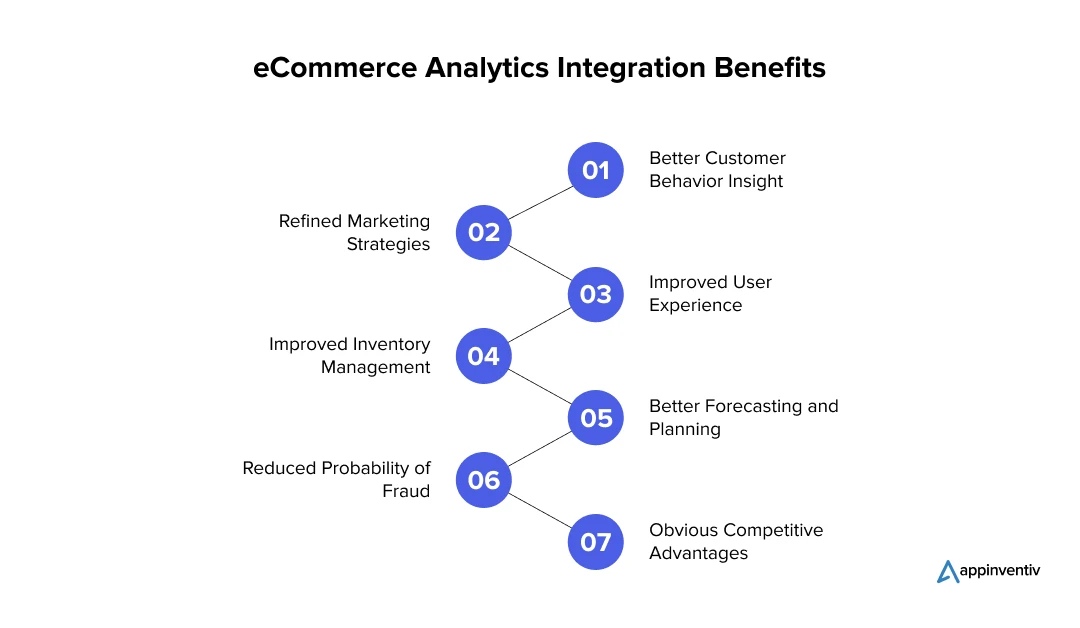
1. Better Customer Behavior Insight
Through eCommerce analytics for businesses, companies can easily track relevant metrics to get valuable insights into customer behavior, choices, and purchasing patterns. By studying a range of data like browsing history, buying history, and demographics, one can get a deep understanding into the target audience and tailor their marketing efforts and product USPs accordingly.
2. Refined Marketing Strategies
e-commerce analytics also helps businesses measure their marketing campaign’s effectiveness in real time. Analyzing KPIs like click-through rates, conversion rates, and return on investment can help them identify which of the marketing channels or plans are driving the most conversions, allowing for better targeted and cost-effective marketing campaigns, which are directed at maximizing ROI.
3. Improved User Experience
By diving into the website traffic, platform navigation patterns, and user engagement metrics, eCommerce analytics tools can help identify improvement areas in the online user experience. This could include optimization of website layout, streamlining of checkout process, or personalization of product recommendations – activities that directly elevate user experience, customer satisfaction and customer loyalty, resulting in improved conversion rates and repeat buys.
4. Improved Inventory Management
e-commerce analytics platforms also provide key insights in inventory management by enabling easy tracking of product performance, demand trends, and stock levels.
Studying insights like seasonal fluctuations, change in market trends, sudden peaks/delines, helps businesses optimize their inventory levels better. This ultimately minimizes instances of stockouts and overstocking, ensuring that right products are available to customers as and when they need it.
5. Better Forecasting and Planning
Advanced analytics for eCommerce platforms usually come integrated with predictive analytics, allowing businesses to get accurate forecasts of future trends and behaviors on the basis of historical data. By using predictive models, eCommerce houses can also easily anticipate customer demands and find emerging market trends. All of this enables them to make data-based decisions on inventory management, pricing strategies, and new product launches.
6. Reduced Probability of Fraud
eCommerce analytics for businesses also help identify and eliminate every possible fraud and security risk. By looking into transaction data and creating patterns that indicate fraudulent activities, businesses can efficiently implement fraud detection measures like multiple factor authentication to protect against hacks and scams.
7. Obvious Competitive Advantages
Utilizing eCommerce data analytics efficiently is non-negotiable in the current competitive landscape. Constantly monitoring performance KPIs, analyzing customer reviews, and staying up-to-date on market movement can help businesses adapt to market changes quickly.
These benefits of eCommerce analytics offer a high-level view of what businesses can expect from the tools’ implementation. Achieving these advantages, however, would depend heavily on the knowledge around the different types of analytics for eCommerce tools available in the market today.
Types of eCommerce Analytics
While the industry has segregated eCommerce analytics for businesses into a wide range of types and models, here’s an overview of the top, most commonly implemented models.
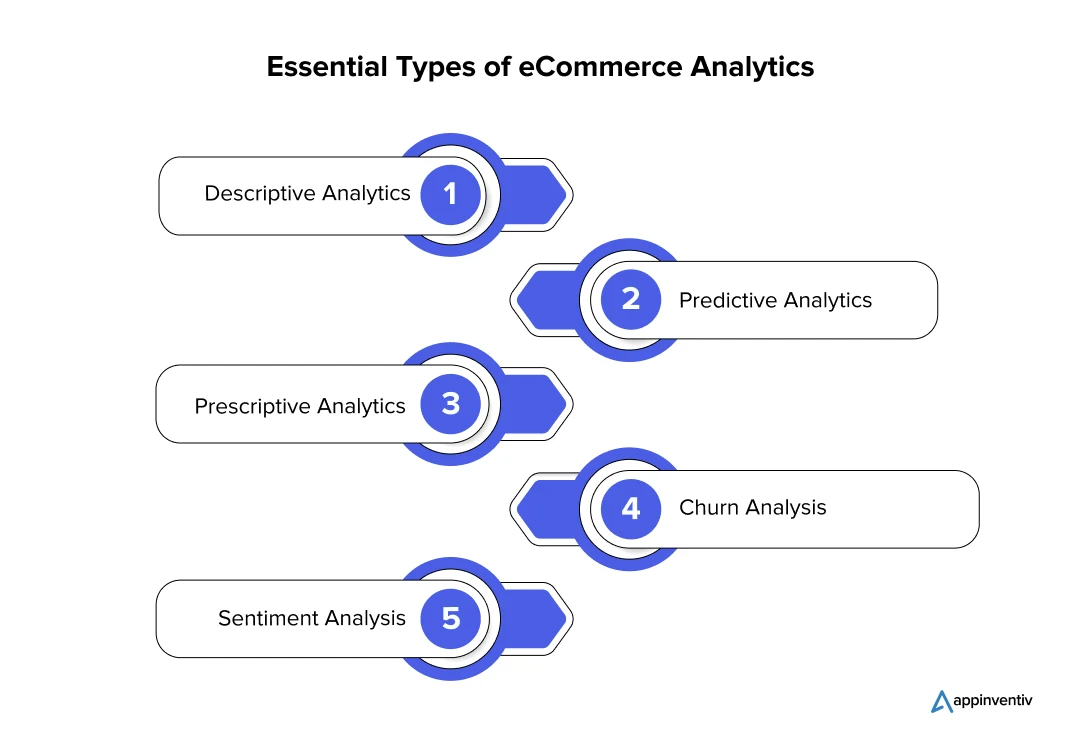
- Descriptive Analytics: The analytics model concentrates on summarizing the platform’s past data to provide insight into what has been happening with the platform. This can include KPIs like sales revenue, website’s traffic, conversion rates, and customer persona, journey.
- Predictive Analytics: They use historical insights and statistical algorithms to predict future outcomes and trends like CLV, product’s demand, and market movement. The information gathered here can help anticipate customer needs and make proactive decisions to monetize on opportunities or eliminate risks.
- Prescriptive Analytics: These tend to go beyond the prediction of future outcomes by suggesting actions to achieve desired goals. By using advanced-level algorithms and operational methods, prescriptive analytics helps businesses identify the effective strategies for maximizing their revenue, minimizing operational costs, and enhancing performance.
- Churn Analysis: The analysis model identifies customers who suddenly stopped engaging with your brand. By studying the churn patterns and knowing the reasons why customers left the platform, businesses can implement effective targeted retention strategies that are aimed at reducing churn rates and increasing customers’ lifetime value.
- Sentiment Analysis: These involve analysis of textual/video data from customer reviews, social media posts, and other sources to determine the sentiment or emotional tone they are associating with your eCommerce platform. By tracking sentiment over a certain period of time, businesses can measure customer satisfaction, find out the areas for improvement, and then respond effectively to customer feedback, while making business-level improvements.
Use Cases and Examples of eCommerce Analytics
e-commerce analytics offers a wealth of insights that can be applied across various aspects of an online business. By leveraging these analytics, entrepreneurs can make data-driven decisions that drive growth, improve customer experience, and increase profitability.
Below are some key use cases of eCommerce analytics, along with real-world examples to illustrate their impact:
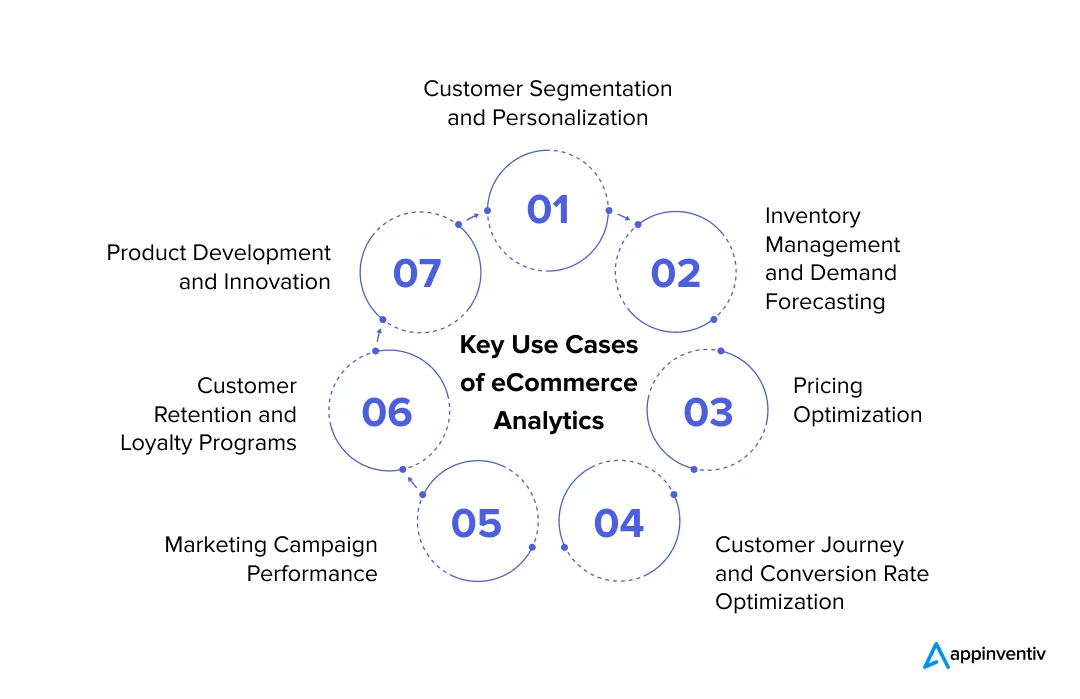
1. Customer Segmentation and Personalization
eCommerce analytics for businesses is aimed at segmenting their customer base into distinct groups based on behavior, demographics, purchase history, and preferences. This segmentation allows for personalized marketing strategies, tailored product recommendations, and targeted promotions.
Example: Amazon uses sophisticated eCommerce data analytics to segment its vast customer base. By analyzing customer behavior and purchase history, Amazon provides personalized product recommendations on the homepage, in emails, and during checkout, significantly increasing the likelihood of repeat purchases.
2. Inventory Management and Demand Forecasting
By analyzing sales trends, seasonality, and customer demand, eCommerce businesses can optimize inventory levels and forecast future demand. This reduces the risk of stockouts or overstock situations, ensuring that popular products are always available when customers need them.
Example: Zara, the global fashion retailer, uses eCommerce analytics to monitor real-time sales data and customer preferences across its online and physical stores. This data-driven approach allows Zara to quickly adjust inventory levels and ensure that their stores and online platforms are stocked with in-demand items, minimizing losses from unsold inventory.
3. Pricing Optimization
eCommerce analytics for businesses helps optimize pricing strategies by analyzing competitors’ prices, customer price sensitivity, and historical sales insights. Dynamic pricing models can be implemented to maximize revenue and stay competitive in the market.
Example: Walmart employs advanced analytics to adjust prices in real-time across its online platform. By continuously monitoring competitors’ prices and customer behavior, Walmart ensures it offers competitive prices, thereby increasing sales while maintaining profit margins.
4. Customer Journey and Conversion Rate Optimization
Understanding the customer journey through eCommerce data analytics allows businesses to identify drop-off points, optimize website design, and enhance user experience, ultimately increasing conversion rates.
Example: ASOS, a popular online fashion retailer, uses eCommerce analytics to track how customers interact with their website – from landing pages to checkout. By analyzing this data, ASOS identified friction points in the checkout process and made improvements that led to a significant increase in their conversion rates.
5. Marketing Campaign Performance
eCommerce analytics enables businesses to evaluate the effectiveness of their marketing campaigns across various channels (e.g., social media, email, PPC). By analyzing key metrics like click-through rates, conversion rates, and ROI, businesses can refine their marketing strategies for better outcomes.
Example: Nike leverages eCommerce analytics to measure the performance of its digital marketing campaigns. By analyzing data from different channels, Nike can identify which campaigns are driving the most traffic and sales, allowing them to allocate their marketing budget more efficiently and achieve a higher return on investment.
[Also Read: The MarTech Advantage – A Guide for CMOs to Unlock Maximum Potential]
6. Customer Retention and Loyalty Programs
Analyzing customer behavior and feedback can help businesses develop effective loyalty programs and retention strategies, leading to increased customer lifetime value.
Example: Starbucks uses data analytics in eCommerce to monitor customer purchases and interactions with their loyalty program. By understanding what motivates repeat purchases, Starbucks tailors its rewards and promotions to encourage customer loyalty, resulting in a higher CLTV and a more engaged customer base.
7. Product Development and Innovation
eCommerce analytics can provide insights into customer preferences, reviews, and market trends, helping businesses innovate and develop new products that align with customer needs.
Example: Glossier, a beauty brand, uses eCommerce analytics to track customer reviews and social media mentions. This data helps them identify gaps in the market and customer pain points, leading to the development of new products that directly address customer desires, contributing to the brand’s rapid growth.
These use cases illustrate how data analytics in eCommerce can be a powerful tool for entrepreneurs, enabling them to make informed decisions that enhance customer satisfaction, streamline operations, and drive business growth.
As we explored here, e-commerce analytics for businesses can be applied across various aspects, from customer segmentation and inventory management to pricing optimization and marketing campaign performance. To fully realize these use cases of eCommerce analytics, it’s essential to have a robust analytics platform equipped with the right features.
Features of a Comprehensive eCommerce Analytics Platform
While the specific features of eCommerce analytics tool would vary depending on the provider and the business needs, a comprehensive end-to-end platform should include the following key features:
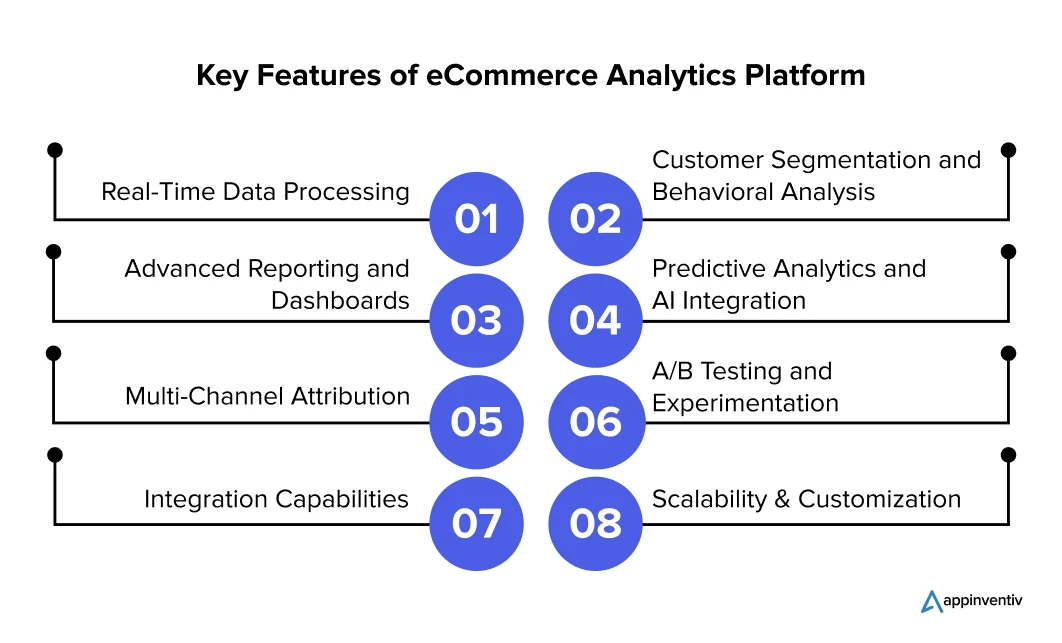
1. Real-Time Data Processing
A comprehensive platform should offer real-time data processing to provide up-to-the-minute insights into customer behavior, sales trends, and inventory levels. This feature is crucial for businesses that need to make timely decisions, such as adjusting prices dynamically or responding to sudden changes in demand.
2. Customer Segmentation and Behavioral Analysis
The ability to segment customers based on various criteria – such as demographics, purchase history, and browsing behavior, is vital. Behavioral analysis tools help businesses understand how different segments interact with their site, enabling personalized marketing and improved customer experiences.
3. Advanced Reporting and Dashboards
A user-friendly dashboard that consolidates data into visual reports is essential for monitoring key performance indicators. Advanced reporting capabilities should allow for customizable reports, enabling businesses to focus on the metrics that matter most to them.
4. Predictive Analytics and AI Integration
Predictive analytics uses historical data to forecast future trends, such as demand fluctuations or customer behavior patterns. Integration with AI can enhance these predictions, providing more accurate insights that help businesses stay ahead of the curve.
5. Multi-Channel Attribution
Understanding the impact of different marketing channels on sales is crucial for optimizing marketing spend. Multi-channel attribution models provide insights into which channels are driving the most conversions, helping businesses allocate resources more effectively.
6. A/B Testing and Experimentation
A/B testing tools allow businesses to experiment with different website elements, such as layout, copy, or product placement, to determine what drives better engagement and conversions. This iterative process is key to continuous improvement.
7. Integration Capabilities
A comprehensive data analytics in eCommerce platform should easily integrate with other tools and systems, such as CRM, ERP, and marketing automation platforms. Seamless integration ensures that data flows smoothly across the organization, providing a holistic view of the business.
8. Scalability and Customization
As a business grows, its analytics needs will evolve. A scalable platform that can handle increasing data volumes and customizable features that adapt to specific business requirements are essential for long-term success.
By offering features like real-time data processing, customer segmentation, predictive analytics, and multi-channel attribution, an eCommerce data analysis platform can transform raw data into actionable insights. Insights that can enable businesses to optimize their operations, enhance customer experiences, and ultimately, increase profitability.
While ready-made eCommerce customer analytics platforms offer a range of powerful features, they often come with challenges that can limit their effectiveness and adaptability. For entrepreneurs, these challenges can hinder the ability to fully leverage analytics for business growth.
Understanding what these challenges could be is crucial when considering whether to opt for an off-the-shelf solution or invest in a custom-built platform.
Challenges Associated with Ready-Made eCommerce Analytics Platforms
Investing in an off-the-shelf solution comes with several glaring (often obvious) challenges. We have had several eCommerce clients come up to us after facing failures with ready-to-install analytics tools in their software, looking for an upgrade into a custom solution.
While we do understand that the buy vs build decision relies heavily on monetary investments, there are some challenges of eCommerce analytics that entrepreneurs should know of when they choose the former vs investing in custom-made eCommerce app development services.
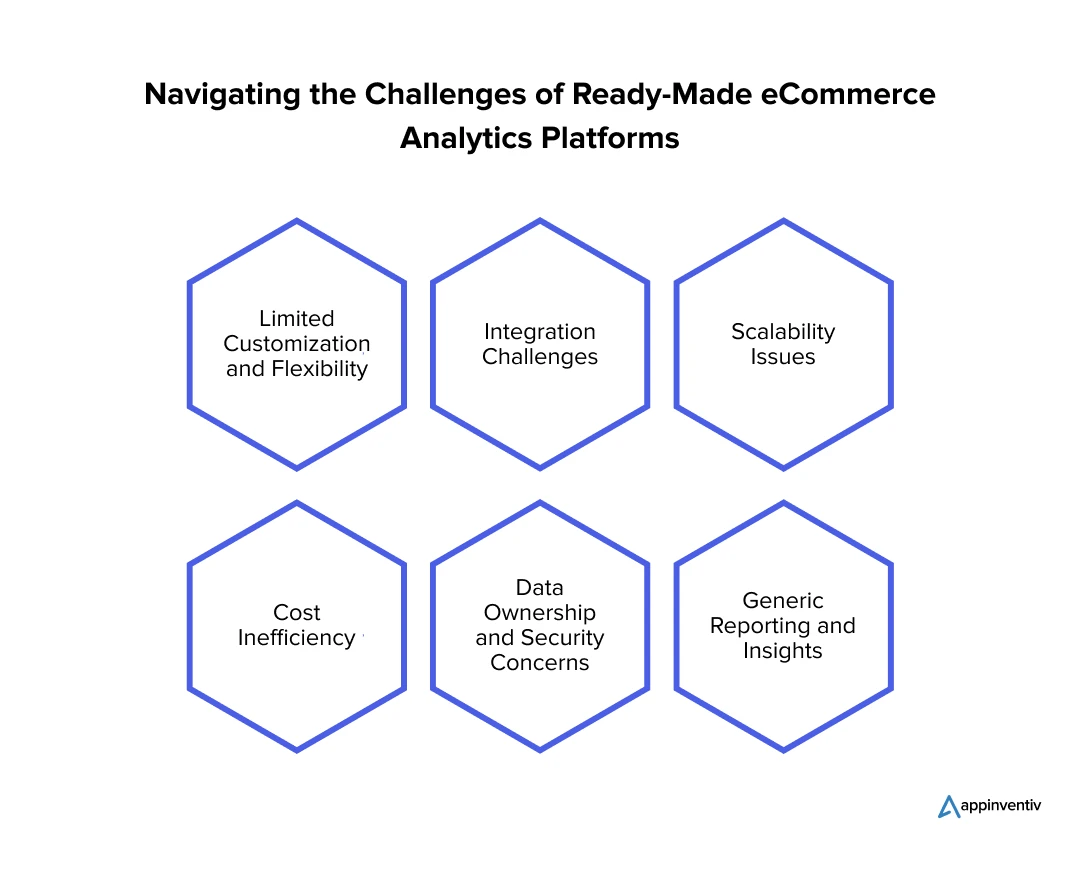
1. Limited Customization and Flexibility
Ready-made platforms are typically designed to cater to a broad audience, which means they may lack the flexibility to adapt to the specific needs of your business. Customization options are often limited, forcing businesses to conform to the platform’s constraints rather than having a solution tailored to their unique processes and goals.
Solution: A custom-built eCommerce analytics platform can be designed with your specific business requirements in mind, offering the flexibility to integrate unique features, workflows, and data sources that align with your business strategy. This ensures that the platform evolves with your business, rather than holding it back.
2. Integration Challenges
Integrating a ready-made analytics platform with your existing systems can be challenging. Many off-the-shelf solutions may not seamlessly connect with your CRM, ERP, or other essential business tools, leading to data silos and inefficient workflows.
Solution: By building a custom eCommerce customer analytics platform, you can ensure seamless integration with all of your existing systems, creating a unified ecosystem where data flows smoothly across all departments. This holistic approach enhances data accuracy and operational efficiency.
3. Scalability Issues
As your business grows, the volume and complexity of your data will increase. Many ready-made analytics platforms are not designed to scale effectively, leading to performance issues, slow data processing, and limited capacity to handle large datasets.
Solution: A custom-built platform can be designed with scalability in mind, allowing it to grow alongside your business. This ensures that your analytics capabilities remain robust and reliable, no matter how large your data volumes become.
4. Cost Inefficiency
While ready-made platforms may seem cost-effective initially, they often come with hidden costs, such as licensing fees, ongoing subscription charges, and additional fees for accessing premium features or higher data limits. Over time, these costs can add up, making the platform less cost-efficient than anticipated.
Solution: A custom-built platform may require a higher upfront investment, but it can be more cost-effective in the long run. With a tailored solution, you avoid unnecessary features and only pay for what you truly need, potentially reducing overall costs and providing better ROI.
5. Data Ownership and Security Concerns
When using a third-party platform, your data is often stored on their servers, raising concerns about data ownership, privacy, and security. You may have limited control over how your data is handled, and in some cases, transferring data between platforms can be complicated and risky.
Solution: A custom analytics in eCommerce platform allows you to maintain full ownership and control of your data. You can implement stringent security measures tailored to your business, ensuring that sensitive information is protected and compliant with relevant regulations.
[Also Read: How can enterprises protect their data in cloud environments?]
6. Generic Reporting and Insights
Ready-made platforms often provide generic reports and insights that may not align with your business’s specific goals or industry nuances. This can lead to missed opportunities or a lack of actionable insights that truly drive growth.
Solution: A custom-built platform can be designed to generate reports and insights that are directly relevant to your business objectives. This ensures that the analytics are meaningful, actionable, and aligned with your strategic goals, empowering you to make informed decisions.
Whether your organization opts for a ready-made platform or decides to build a custom solution, successful implementation is key to unlocking the full potential and importance of eCommerce analytics for your business. Adhering to best practices during the implementation process ensures that your analytics platform is effective, scalable, and aligned with your business goals. Here are some eCommerce analytics best practices to follow, regardless of whether you choose to buy or build.
Best Implementation Practices for eCommerce Analytics
Adding an eCommerce analytics tool into your product would call for a careful evaluation of not just the solution but also your business’s preparedness.
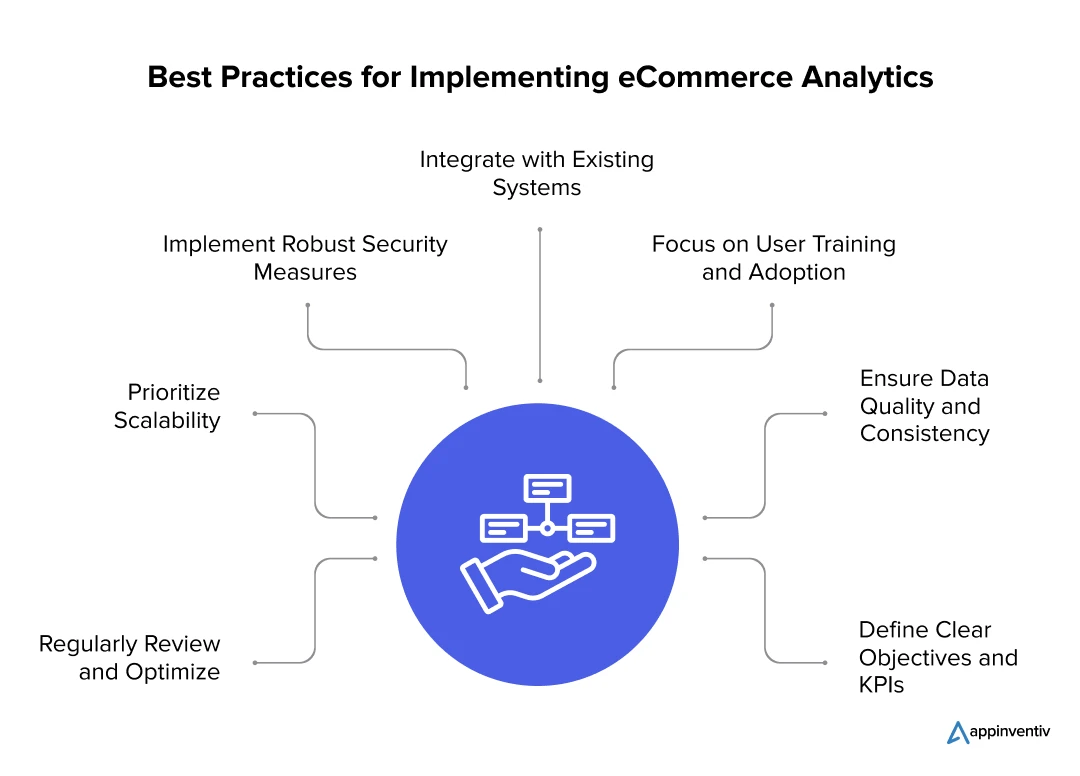
1. Define Clear Objectives and KPIs
Before implementing an eCommerce analytics platform, it’s crucial to define clear objectives and key performance indicators. Understanding what you want to achieve with your analytics – whether it’s improving customer retention, optimizing marketing campaigns, or enhancing inventory management – will guide the entire implementation process.
Engaging with key stakeholders across departments to establish common goals and relevant KPIs ensures that the platform meets the specific needs of your business and provides actionable insights that drive results.
2. Ensure Data Quality and Consistency
The effectiveness of your analytics platform is only as good as the quality of the data it processes. Inconsistent, incomplete, or inaccurate data can lead to misleading insights and poor decision-making.
Implementing data governance protocols that include regular data audits, validation processes, and standardization of data formats ensures that your platform works with clean, reliable data, leading to more accurate and trustworthy insights.
3. Focus on User Training and Adoption
Even the most sophisticated analytics platform can fall short if your team doesn’t know how to use it effectively. Ensuring that your team is well-trained and comfortable using the platform is essential for maximizing its value.
Investing in comprehensive training programs that cover both the technical aspects of the platform and how to interpret and act on the insights it generates is crucial. Ongoing support and resources should also be provided to encourage continuous learning and adaptation as the platform evolves.
4. Integrate with Existing Systems
For your analytics platform to provide a holistic view of your business, it needs to be seamlessly integrated with your existing systems, such as CRM, ERP, and marketing automation tools.
Planning for integration from the outset, identifying key systems that need to be connected to the analytics platform, and working with your IT team or external experts to ensure smooth integration minimizes disruptions and ensures that data flows seamlessly between systems.
5. Implement Robust Security Measures
Data security is a critical consideration in any eCommerce customer data and analytics implementation. Protecting sensitive customer and business data from unauthorized access, breaches, or leaks is essential for maintaining trust and compliance with regulatory requirements.
Implementing robust security measures, including encryption, access controls, and regular security audits, ensures that your platform complies with relevant data protection regulations, such as GDPR or CCPA, and that your team is trained in best practices for data security.
6. Prioritize Scalability
As your business grows, your analytics needs will evolve. It’s important to implement a platform that can scale with your business, accommodating increasing data volumes, more complex queries, and additional users without compromising performance.
Choosing or building a platform designed with scalability in mind and regularly reviewing and optimizing the platform’s performance ensures it continues to meet your business’s growing demands.
7. Regularly Review and Optimize
The implementation of an eCommerce customer data and analytics platform is not a one-time project but an ongoing process. Regularly reviewing the platform’s performance, the accuracy of its insights, and its alignment with business goals is essential for continuous improvement.
Establishing a schedule for regular reviews and optimization sessions and involving stakeholders from different departments to gather feedback helps identify areas for improvement and ensures that the platform remains aligned with your business needs and continues to deliver value.
How Can Appinventiv Help Elevate Your Ecommerce Analytics Strategy
Analytics for eCommerce is essential for businesses to thrive in today’s competitive landscape, offering insights that drive growth, optimize operations, and enhance customer satisfaction.
However, ready-made platforms often lack the customization, integration, and scalability that businesses need. At Appinventiv, we specialize in building custom eCommerce analytics solutions tailored to your unique needs, ensuring that your platform is scalable, secure, and capable of delivering actionable insights.
In our decade long experience of collaborating with different startups and enterprises, we have developed robust, result-oriented products for some of the biggest eCommerce brands, including Adidas and 6th Street.
Choosing us would mean partnering with a top-tier development team committed to helping your business succeed with a powerful, customized eCommerce customer data and analytics platform.
Reach out to us with your eCommerce analytics idea, today.
FAQs
Q. How can online businesses use data analytics to increase sales?
A. Online businesses can use data analytics to understand customer behavior, optimize pricing, personalize marketing campaigns, and identify trends. By analyzing data, businesses can make informed decisions that lead to improved customer experiences, targeted promotions, and increased conversion rates, ultimately driving higher sales.
Q. What is eCommerce analytics?
A. Ecommerce analytics for businesses is the process of collecting, analyzing, and interpreting data related to online sales, customer behavior, and marketing efforts. It helps businesses track performance, understand customer preferences, and optimize their online strategies to boost sales and enhance customer satisfaction.
Q. How does eCommerce analytics increase your sales?
A. Ecommerce analytics increases sales by providing insights into customer buying patterns, allowing businesses to optimize product offerings, improve user experience, and run more effective marketing campaigns. This data-driven approach leads to better-targeted efforts, reduced cart abandonment, and higher conversion rates.



How Much Does It Cost to Build an E-commerce App Like Noon?
Key takeaways: Noon’s success highlights the rising demand for mobile-first eCommerce in the UAE. Building a similar app can cost anywhere between $ 30,000 and $200,000+, depending on the scope. The blog covers all key user and admin features needed to build a Noon-like app. Identify key cost drivers, including feature complexity, scalability, platform, and…

How to Build a Quick Commerce App? Features, Process, Costs
Key Takeaways Quick commerce is a rapidly growing market driven by consumer demand for ultra-fast delivery and seamless convenience, projected to reach 900 million users by 2029. Quick commerce app development costs vary widely based on features and scale, ranging from $40,000 for an MVP to $400,000+ for a fully featured app. Core features, such…

Top 20 Lucrative eCommerce Business Ideas to Start in 2025
Ryan Barr, the owner of WP Standard, wakes up each morning to the sounds of online sales notifications. From the humble beginnings of crafting leather guitar cases, his morning routine now celebrates the thriving expansion of WP Standard into a seven-figure e-commerce empire. Let’s look back to the beginning Ryan started WP Standard with just…


















